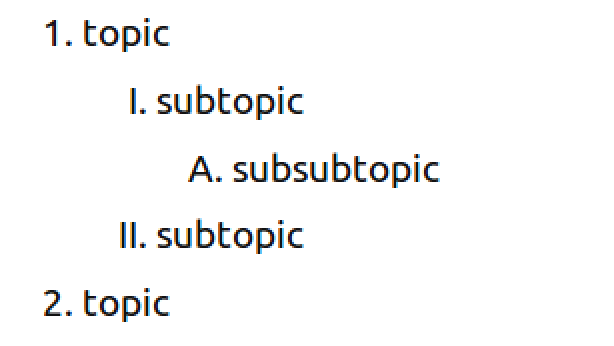Introduction:
While writing a response to a question, I came to a situation where making a sublist improved readability of the post.
This works:
- topic
- subtopic
- subsubtopic
- subtopic
- subtopic
- topic
Although the indentation helps, this could present some confusion between topic and subtopic.
This works also works:
- topic
- subtopic
- subsubtopic
- subtopic
- subtopic
- topic
However, it doesn't fit a formal text style. Attempts to create an alternate numbering for the sublist failed.
Formal style:
Decimal List:
1. topic
1.1 subtopic
1.1.1 subsubtopic
1.2 subtopic
2. topic
This style is probably most appropriate for the case I encountered but isn't supported by HTML. It could be done with CSS, but I don't think is would be as easy as the next style.
Outline style:
1. topic
I. subtopic
A. subsubtopic
II. subtopic
2. topic
This style is supported by HTML by using the type= option in the ordered list tag. The above list can be produced with the following code:
<ol type="1">
<li>topic</li>
<ol type="I">
<li>subtopic</li>
<ol type="A">
<li>subsubtopic</li>
</ol>
<li>subtopic</li>
</ol>
<li>topic</li>
</ol>
However, the page renderer here converts this to unordered lists.
Proposed Implementation:
It seems that a minor edit and replication of existing code would enable the outline format.
Typed Character| Converts to
-----------------------------------------
1. | <ol type="1">
A. | <ol type="A">
I. | <ol type="I">
a. | <ol type="a">
leading spaces | creates sublist #already implemented
blank line | ends current list #already implemented
Reason for making the change:
The ability to create sublists greatly improves the readability of complex explanations or multi step processes. To help the reader distinguish sublist from main list, the sublist should have a different numbering system.
Example: https://askubuntu.com/a/985039/694267
Comparison:
Original Text:
- Kernel 4.0 and newer, the lazytime option reduces writes to disk by maintaining changes to inode timestamps (access, modification and creation times) only in memory. The on-disk timestamps are updated only when either (1) the file inode needs to be updated for some change unrelated to file timestamps, (2) a sync to disk occurs, (3) an undeleted inode is evicted from memory or (4) if more than 24 hours passed since the the last time the in-memory copy was written to disk.
Same Numbering:
Kernel 4.0 and newer, the lazytime option reduces writes to disk by maintaining changes to inode timestamps (access, modification and creation times) only in memory. The on-disk timestamps are updated only when either:
- the file inode needs to be updated for some change unrelated to file timestamps,
- a sync to disk occurs,
- an undeleted inode is evicted from memory or
- if more than 24 hours passed since the the last time the in-memory copy was written to disk
Different numbering:
Kernel 4.0 and newer, the lazytime option reduces writes to disk by maintaining changes to inode timestamps (access, modification and creation times) only in memory. The on-disk timestamps are updated only when either:
a. the file inode needs to be updated for some change unrelated to file timestamps,
b. a sync to disk occurs,
c. an undeleted inode is evicted from memory or
d. if more than 24 hours passed since the the last time the in-memory copy was written to disk
EDIT: Reply to Thomas Ward
I could easily just write my answer as done above; however, would that start another bashing for not using the system's ordered list function? Granted the need for dropping to a third level in an answer does not occur often, but there is some need to do so in a thorough explanation.
Outline vs Ordered List:
As shown by my examples of what works, the system already supports the needed elements except for differentiated numbering. A system enforced numbering scheme would be ok. Though, it seems that a user selected numbering would be easier to implement.
Formal Style References:
APA writing style - https://owl.english.purdue.edu/owl/resource/544/03/
MLA writing style - http://www.newarkhs.k12.il.us/_sr_project/portfolio_pdfs/HackerLevi-MLA-Out.pdf
Chicago writing style - https://www.cmich.edu/colleges/chsbs/Centers/WritingCenter/Documents/Quick

